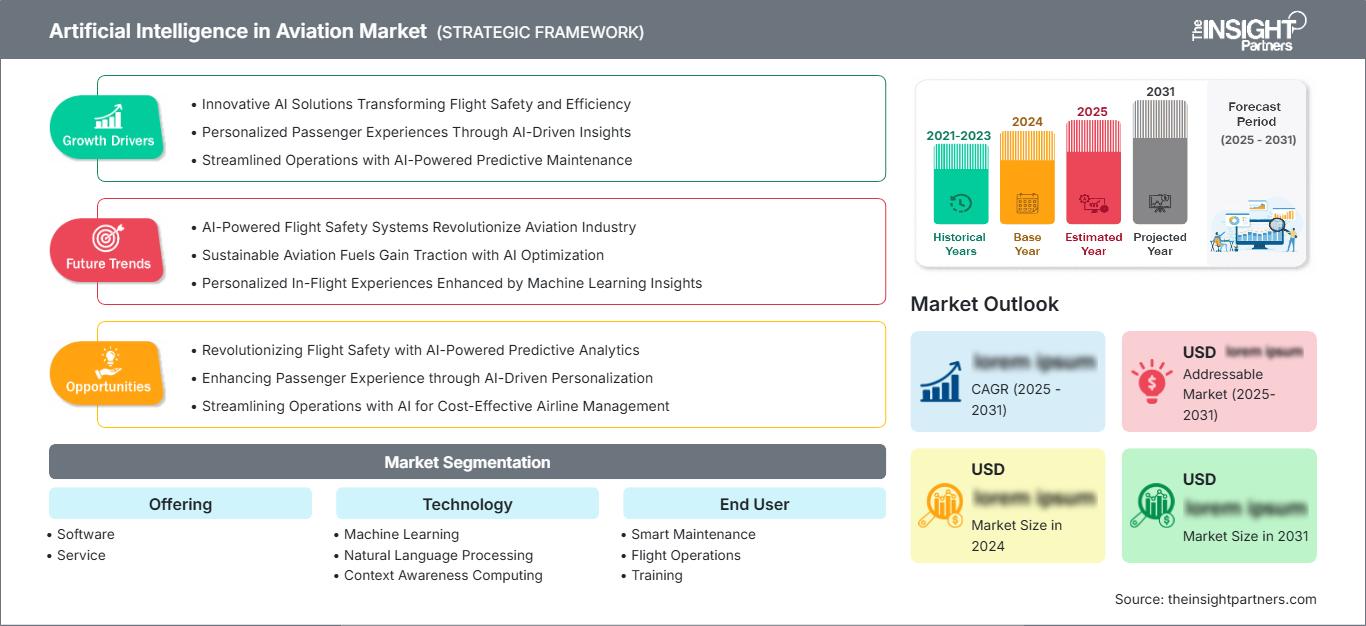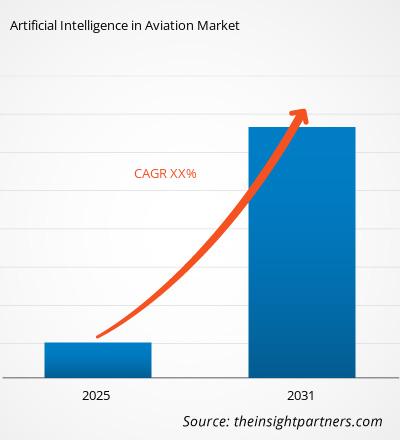Der Markt für Künstliche Intelligenz in der Luftfahrt wird bis 2031 voraussichtlich ein Volumen von 9,5 Milliarden US-Dollar erreichen. Für den Zeitraum 2025–2031 wird ein jährliches Wachstum von 38,0 % erwartet.
Der Bericht ist nach Angebot (Software, Service) kategorisiert und analysiert den Markt zudem nach Technologie (Maschinelles Lernen, Verarbeitung natürlicher Sprache, Kontextbezogenes Computing, Computer Vision). Er untersucht den Markt auch nach Endnutzer (Intelligente Wartung, Flugbetrieb, Training, Überwachung). Für jedes dieser Schlüsselsegmente wird eine umfassende Aufschlüsselung auf globaler, regionaler und Länderebene bereitgestellt. Der Bericht enthält Marktgrößen und Prognosen für alle Segmente, angegeben in US-Dollar. Er liefert außerdem wichtige Statistiken zum aktuellen Marktstatus führender Akteure sowie Einblicke in vorherrschende Markttrends und neue Chancen.
Der Bericht „Markt für Künstliche Intelligenz in der Luftfahrt“ von The Insight Partners beschreibt die aktuelle Marktlage und das zukünftige Wachstum sowie die wichtigsten Treiber, Herausforderungen und Chancen. Dies wird verschiedenen Akteuren im Geschäftsbereich Einblicke ermöglichen, wie beispielsweise:
- Technologieanbieter/Hersteller: Um die sich entwickelnde Marktdynamik zu verstehen und potenzielle Wachstumschancen zu erkennen, können sie fundierte strategische Entscheidungen treffen.
- Investoren: Um eine umfassende Trendanalyse hinsichtlich Marktwachstumsrate, Finanzprognosen und Chancen entlang der Wertschöpfungskette durchzuführen.
- Regulierungsbehörden: Um Richtlinien zu regulieren und Aktivitäten auf dem Markt zu überwachen, mit dem Ziel, Missbrauch zu minimieren, das Vertrauen der Anleger zu wahren und die Integrität und Stabilität des Marktes zu gewährleisten.
Segmentierung des Marktes für künstliche Intelligenz in der Luftfahrt
- Software
- Service
Technologie
- Maschinelles Lernen
- Verarbeitung natürlicher Sprache
- Kontextbezogenes Computing
- Computer Vision
Endnutzer
- Intelligente Wartung
- Flugbetrieb
- Schulung
- Überwachung
Sie erhalten kostenlos Anpassungen an jedem Bericht, einschließlich Teilen dieses Berichts oder einer Analyse auf Länderebene, eines Excel-Datenpakets sowie tolle Angebote und Rabatte für Start-ups und Universitäten.
Künstliche Intelligenz im Luftfahrtmarkt: Strategische Einblicke

-
Holen Sie sich die wichtigsten Markttrends aus diesem Bericht.Dieses KOSTENLOSE Beispiel umfasst Datenanalysen, die von Markttrends bis hin zu Schätzungen und Prognosen reichen.
Wachstumstreiber des Marktes für Künstliche Intelligenz in der Luftfahrt
- Innovative KI-Lösungen transformieren Flugsicherheit und Effizienz
- Personalisierte Passagiererlebnisse durch KI-gestützte Erkenntnisse
- Optimierte Abläufe durch KI-gestützte vorausschauende Wartung
Zukunftstrends des Marktes für Künstliche Intelligenz in der Luftfahrt
- KI-gestützte Flugsicherheitssysteme revolutionieren die Luftfahrtindustrie
- Nachhaltige Flugkraftstoffe gewinnen durch KI-Optimierung an Bedeutung
- Personalisierte Flugerlebnisse verbessert durch Erkenntnisse aus maschinellem Lernen
Marktchancen für Künstliche Intelligenz in der Luftfahrt
- Revolutionierung der Flugsicherheit durch KI-gestützte prädiktive Analysen
- Verbesserung des Passagiererlebnisses durch KI-gestützte Personalisierung
- Optimierung der Abläufe mit KI für kosteneffiziente Fluggesellschaften Management
Künstliche Intelligenz im Luftfahrtmarkt
Die regionalen Trends und Einflussfaktoren auf den Markt für Künstliche Intelligenz in der Luftfahrt während des gesamten Prognosezeitraums wurden von den Analysten von The Insight Partners ausführlich erläutert. Dieser Abschnitt behandelt außerdem die Marktsegmente und die geografische Verteilung des Marktes für das Management von Herzrhythmusstörungen in Nordamerika, Europa, dem asiatisch-pazifischen Raum, dem Nahen Osten und Afrika sowie Süd- und Mittelamerika.
Berichtsumfang zum Thema Künstliche Intelligenz in der Luftfahrt
| Berichtsattribut | Einzelheiten |
|---|---|
| Marktgröße in 2024 | US$ XX Billion |
| Marktgröße nach 2031 | US$ 9.5 Billion |
| Globale CAGR (2025 - 2031) | 38.0% |
| Historische Daten | 2021-2023 |
| Prognosezeitraum | 2025-2031 |
| Abgedeckte Segmente |
By Angebot
|
| Abgedeckte Regionen und Länder |
Nordamerika
|
| Marktführer und wichtige Unternehmensprofile |
|
Künstliche Intelligenz in der Luftfahrtbranche: Dichte der Marktteilnehmer – Auswirkungen auf die Geschäftsdynamik
Der Markt für künstliche Intelligenz in der Luftfahrt wächst rasant, angetrieben durch die steigende Nachfrage der Endnutzer. Gründe hierfür sind unter anderem sich wandelnde Verbraucherpräferenzen, technologische Fortschritte und ein wachsendes Bewusstsein für die Vorteile des Produkts. Mit steigender Nachfrage erweitern Unternehmen ihr Angebot, entwickeln innovative Lösungen, um den Kundenbedürfnissen gerecht zu werden, und nutzen neue Trends, was das Marktwachstum weiter ankurbelt.

- Holen Sie sich die Künstliche Intelligenz im Luftfahrtmarkt Übersicht der wichtigsten Akteure
Wichtigste Verkaufsargumente
- Umfassende Abdeckung: Der Bericht bietet eine umfassende Analyse der Produkte, Dienstleistungen, Typen und Endnutzer des Marktes für Künstliche Intelligenz in der Luftfahrt und vermittelt so ein ganzheitliches Bild.
- Expertenanalyse: Der Bericht basiert auf dem fundierten Wissen von Branchenexperten und Analysten.
- Aktuelle Informationen: Der Bericht gewährleistet Geschäftsrelevanz durch die Berücksichtigung aktueller Informationen und Datentrends.
- Anpassungsmöglichkeiten: Dieser Bericht kann an spezifische Kundenanforderungen angepasst werden und sich optimal in die Geschäftsstrategien integrieren.
Der Forschungsbericht zum Markt für Künstliche Intelligenz in der Luftfahrt kann somit maßgeblich dazu beitragen, das Branchenszenario und die Wachstumsaussichten zu entschlüsseln und zu verstehen. Auch wenn einige berechtigte Bedenken bestehen, überwiegen die Vorteile dieses Berichts insgesamt die Nachteile.
- Historische Analyse (2 Jahre), Basisjahr, Prognose (7 Jahre) mit CAGR
- PEST- und SWOT-Analyse
- Marktgröße Wert/Volumen – Global, Regional, Land
- Branchen- und Wettbewerbslandschaft
- Excel-Datensatz
Aktuelle Berichte
Erfahrungsberichte
Grund zum Kauf
- Fundierte Entscheidungsfindung
- Marktdynamik verstehen
- Wettbewerbsanalyse
- Kundeneinblicke
- Marktprognosen
- Risikominimierung
- Strategische Planung
- Investitionsbegründung
- Identifizierung neuer Märkte
- Verbesserung von Marketingstrategien
- Steigerung der Betriebseffizienz
- Anpassung an regulatorische Trends






















 Kostenlose Probe anfordern für - Künstliche Intelligenz im Luftfahrtmarkt
Kostenlose Probe anfordern für - Künstliche Intelligenz im Luftfahrtmarkt